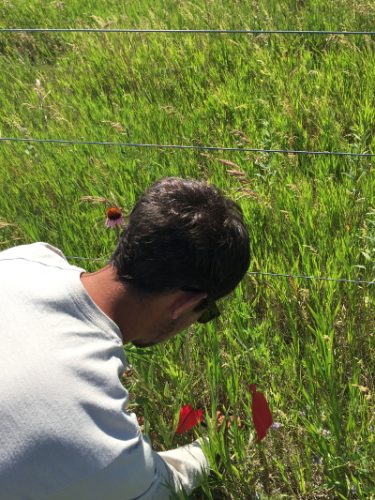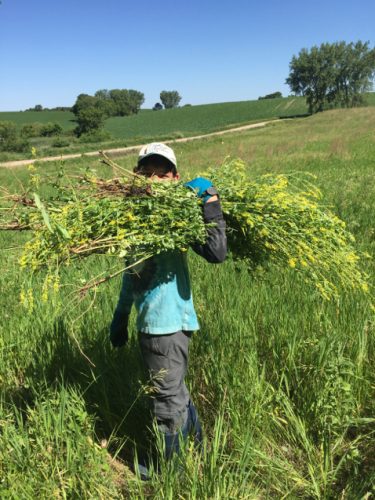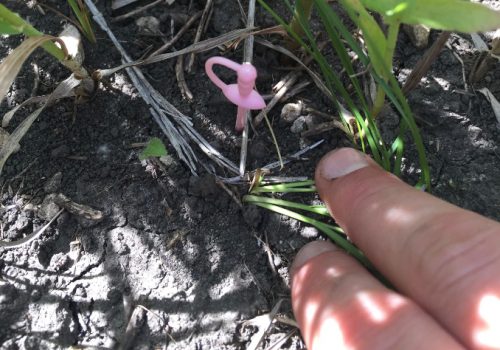|
|
Hello, devotees,
There was a lot of hoopla over the weather today. It got up into the lower 90s with humidity ranging from 70 – 90%. The natives tell me that this is very hot and unusual for the area. For those fellow Virginians out there, it was maybe a little bit cooler than an average day.
To beat the heat, we started at 8:00 this morning. Leah and Alex started the day catching bees at Aanenson and the Landfill, while Jennifer and Laura returned to P2 (where the P apparently stands for ‘purgatory’). The rest of us did phenology. I went with Amy and Will to our transect Staffanson, where the burned West unit was in full bloom and the unburned East unit was on its way out. We found eight new flowering plants at Staffanson today. Lea and Jame did the Northwest route, where thankfully this time nobody was left behind. Gretel and Alyson knocked out the southwest route, while Abby did the East and P1 (no other P though).
Today’s lunch was one of our more controversial ones. For one, Lea ate two pieces of watermelon instead of one. Personally, I was fuming. Instead of eating watermelon, I was forced to eat one of Will’s tiny grapes. After lunch, a few of us enjoyed cups of shirts-on coffee, while strategizing for measuring plants in P1. Today we set forth to conquer INB2 — an experiment studying the fitness of inbred plants. See picture for summary.
 Relevant reading for measuring plants in P1
Amidst all the duff and dirt-colored staples, we put our meter sticks to good use measuring these crosses for an hour and a half. Mercifully, Stuart and Gretel allowed us to stop measuring early in the afternoon as we crossed the vaunted 90 degree threshold. From here, some went to Elk Lake, where I participated in an endurance water-treading contest that apparently nobody else was aware of, and still lost. The Wagenius family was also there, taking a quick dip before going to the library. Others stayed at the Hjelm House for independent project related work. We ate some great alfredo courtesy of Alyson, where the mystery ingredient was cheese curds. While eating, we were engrossed in a who-has-longer-arms tournament, where Laura pulled off several upsets but still came up just a little bit short of the crown. We’re preparing ourselves for tomorrow’s heat, turning on seemingly every appliance in the kitchen to make some ginger beverage and banana bread. We’re starting again at 8:00 tomorrow, but if today has taught us anything, it’s that it’s never too early to start sweating.
 Lea does the reverse-sauna in the freezer.
Here is a proposal for a fun project. It involves using demography data from this (and prior) years to estimate the growth rates of each of the remnants individually. Actually, that’s basically the whole project. Action items for the next month include: reading technical manuals with specifics on implementing aster models (see the list of project publications if you want to read them for me on your own).
scott_proposal_1
In other Scott-research related news, I will also try modeling fitness of various Hesperostipa spartea crosses in experimental plot 1. Just today I got a list of positions of plants found alive in 2016 — my plan in the near future is to search positions in the plot where plants were found alive in 2011 but weren’t found in 2016 to assess mortality. Keep your eyes open for another action-packed research proposal for this porcupine grass-ey project.
Hello, dark fringes of the web,
Sunday began literally with a bang, as we had thunderstorms all throughout the night. Most of us slept pretty well, I think. Still, there were definitely some thunderclaps right over us in Kensington. Despite this, Alex, Amy, Laura and Leah woke up early in the morning to do some field work for independent projects. Leah, Amy and Alex visited some of our Northwest sites to catch pollinators. Unfortunately, the cool weather and wet conditions meant that there were a whopping zero pollinators to be caught for Leah’s project. However, she did get this pretty hilarious picture of a Melissodes (long horned bee) on a stick.
 Straight muggin with a bee on a stick. Amy had better luck, and did style persistence well into the afternoon, despite some scary looking clouds and losing a coveted sharpie.
The rest of us had more relaxed days. Lea made soup with some of our left over vegetables. James recovered from a mystery illness. Laura and I found a large beetle on the porch of Town Hall, which excreted a mystery liquid from its back when poked. It was really funny, but only because I wasn’t the one who touched the beetle. Many of us put finishing touches on our independent project proposals, and we began editing (ahem, peer reviewing) each others’. We finally followed through on our longstanding plans to have brinner ( = breakfast dinner). Amy, Lea, Laura and I made hash (no, not that hash) with onions and spotty yellow kale, an egg scramble with onions, kohlrabi greens, and Napa cabbage, and pancakes with mystery ingredients. Somehow, we still have lots of onions left — if only we put them in the pancakes! Over dinner, we talked about how to survive a tornado (hint: hide in the bathroom), among other things, and tried to convince James that he was having a fever dream. Tomorrow is back to the field for phenology and whatever else the weather allows.
 “Fever dreams” by Laura
Hi world,
The first big issue of the day was the lone radish found in the fridge today. We tried to peddle it onto everybody on the crew, but most people thought it looked too smooshy, and nobody wanted to smoosh. Amy and I eventually split it in half and ate it before jumping in the car. Picture attached. It turned out to actually be one of our spicy radishes. I think that was appropriate because today was a spicy day.
 Spicy radish. Would you have eaten it? This day started out with distant sheets of rain that slowly crept up to base at the Hjelm House, forcing us to do indoor work. When the rain cleared around 9:30, crew members did bee observation videos. Some people were viewing bees for the first time, others were going out for their second stints. We saw some of the same patterns today that we say two days ago — Laura saw over 20 bees at Steven’s Approach, while other sites were pretty destitute. Other crew members worked on mapping and pulling hawkweed for a hawkweed eradication experiment in experimental plot 1. Also, we finished collecting our qGen2 experiment data for the year, freeing up more time and plastic toothpicks for other projects.
At lunch, to supplement our training yesterday on flower deformities, we talked about our own various human deformities, including dislocated fingers, weird moles and warts, and bruised ribs. We may make a fun little trip this weekend into Alexandria to visit an urgent care facility. From there, most of the crew split off to do phenology and GPSing. Alyson went to the bog, and Leah finished setting up plots for her own pollinator observations, and the family stayed behind to weed (including some gnarly thistles). I went up the Landfill bloc geotagging with Alex, with Abby and Lea doing phenology at the sites ahead of us and catching over 50 new buds. We GPSed over 60 flowers alone at Around Landfill and got over 80 flowers total. James and Will were able to finish mapping five sites on their own. All of this done with zero people getting electrocuted on the electric fence near the Landfill.
 Alex narrowly escapes death, checking a tag for an an Echinacea under the electric fence at Around Landfill. At home, Leah and Amy made dank filafel and salad. We all discovered that mint works just as well as dill in tzatziki sauce. After that, we played Farkle well into the night, with Amy “Farkle Queen” Waananen winning two games, the first one in a wild horse race with Lea “The Farkle Hustler” Richardson. We look forward to our Friday Pizza and Farkle night tomorrow, followed by more Farlke-related activities over the long weekend.
The gang had a busy day today, almost all of it in the warm June sun. Alyson continued setting up her experimental plots in the Staffanson bog, and spent the afternoon measuring canopy cover and soil pH for her IS project. Meanwhile, the rest of the team (minus Gretel, who was setting up work for q2 juvenile counts) picked up our fleg begs and counted Hesperostipa spartea and weeded in p1. Amy and James found one H. spartea specimen with 137 seeds! We are now up to 17 out of 59 rows surveyed. Meanwhile, Will, Alex and Per led the crew in weeding out the non-native yellow sweet clover (Melilotus) from the periphery of the plot area. Hopefully we eliminated a lot of potential seeds form the seed bank, meaning that in future years the rows will be devoid of this weedy legume and the study Echinacea will have less competition. Stuart also showed me what poison ivy looks like for the third time, and I still don’t think I could pick it out of a lineup.
 Per with a bundle of sweet clover picked from around p1. This is probably less than 10% of what was removed today. After some brief (or for Alex, who was cleaning the bathroom, not so brief) chores at the Hjelm House, the team returned to exPt8 (experimental plot 8) to search for juvenile Echinacea crosses planted in 2013. This meant more time bent over, although now instead of looking for seedlings we were looking for melted bits of toothpick (which were placed to mark seedlings). Some seedlings were in great shape — Alex and I found a couple with basal leaves over 10 cm tall. Others were not in great shape, either dead or missing like Jimmy Hoffa. We got about a third of the work for qGen2 this afternoon. It may rain tomorrow, so we’re bracing for indoors-work and hiding our bicycles inside.
 Using a pink sword to claim the new seedling (left) for Team Echinacea. We used cocktail swords to denote seedlings germinating this year from achenes sown in 2013.
Scott Nordstrom
Echinacea Project 2016
Biology, Math, William and Mary 2015. Operations Research, William and Mary, 2016.
Research Interests
I am interested in studying how complex systems assemble and function. I’m especially interested in pollination ecology (properties of plant-pollinator networks) and spatial processes in ecology. My ideal job is to spend the summer months on the side of a mountain catching butterflies, then spending the rest of the year playing around with data on the computer. I’m new to the prairie ecosystem, so I’m excited to learn it inside and out and contribute to exciting research projects.
Statement
I am from Burke, Virginia, in the suburbs of D.C. I’ve done field work in Oregon, Idaho, Vermont and Maine before this summer. In my spare time I like to hike, run, cook, drink coffee, and listen to my local public radio station.
 Me with my vegetable of choice.
|
|









